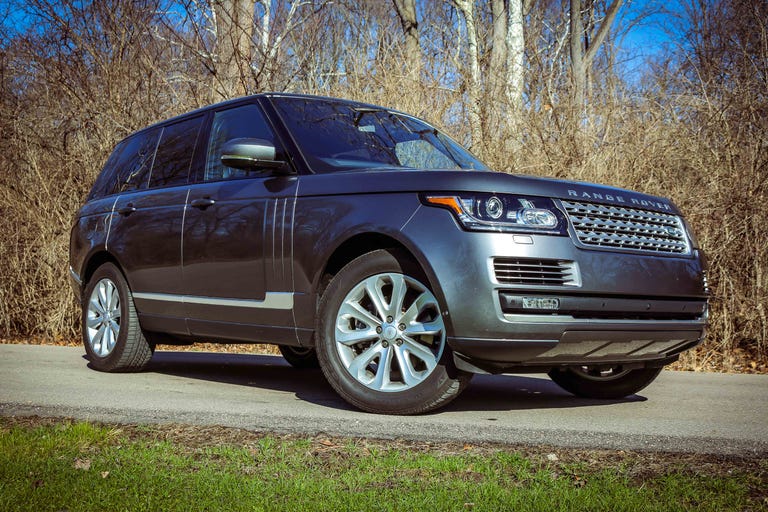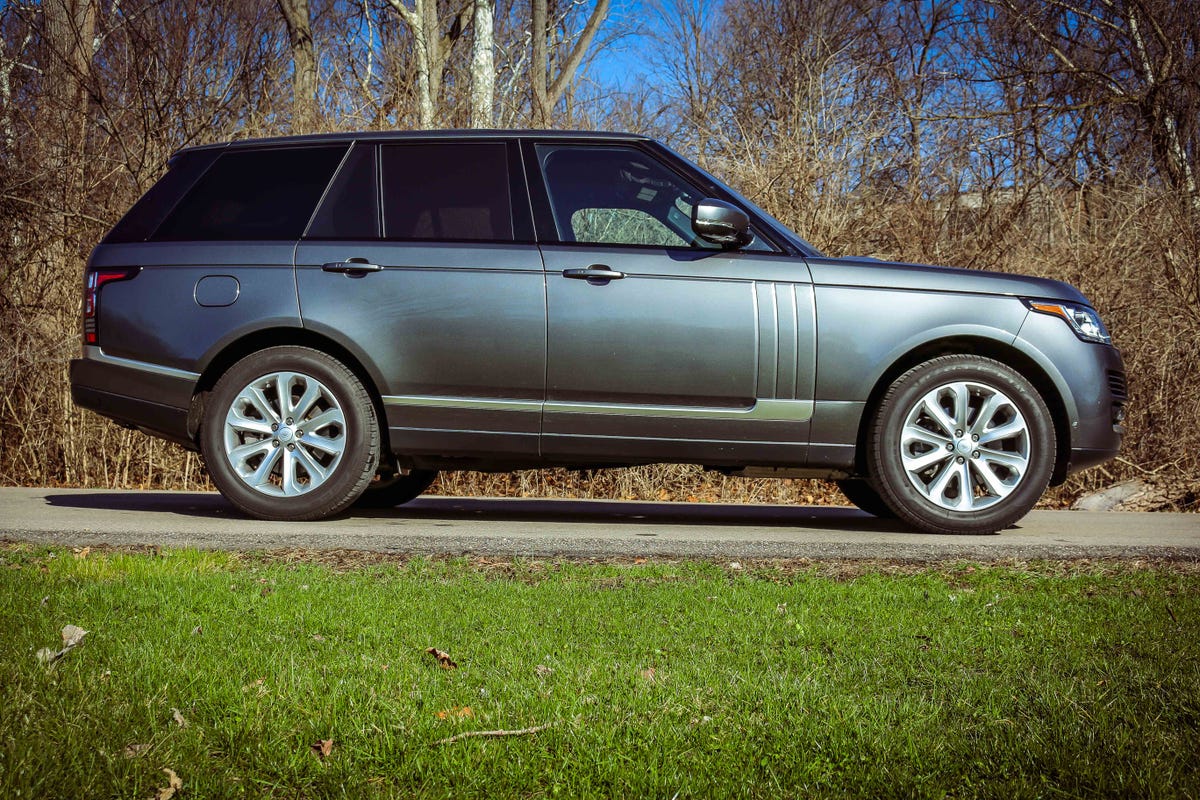 Why You Can Trust CNET
Why You Can Trust CNET 2017 Land Rover Range Rover review: Land Rover's diesel gives the 2017 Range Rover killer torque and range
Land Rover steps up the efficiency game of its king-of-the-hill Range Rover with a new diesel option offering up to 658 miles of cruising range.
Model year 2017 changes:
The Good
The Bad
The Bottom Line
SVAutobiography Dynamic model is new to the range built on a standard wheelbase featuring a specially tuned suspension for improved on road capabilities.
Advanced tow assist and speed limiter added to All-Terrain Progress Control system.
InControl Touch Pro infotainment with a 10.2-inch touchscreen standard.
New all-terrain info center and low traction launch systems.
Editors' note, September 5, 2017: This review was written based on an evaluation of the 2016 Land Rover Range Rover. See the changes for the 2017 model year above.
With nearly 100 miles on the trip odometer, the fuel gauge on the big Land Rover Range Rover HSE Td6's TFT display hasn't really budged. I wonder aloud to myself if there's a problem. Maybe a bad sensor or some other electrical glitch? Given the checkered history of British vehicle electronics, a faulty gauge isn't out of the realm of possibility, right? Turns out, the gauge did work and began to drop -- slowly.
Diesel power adds to the appeal of the 2016 Land Rover Range Rover (pictures)
See all photosDiesel heart
Under the Range Rover's clamshell hood sits a new Td6 3.0-liter turbo diesel V-6 engine, which explains this leather-lined behemoth's fuel-sipping tendencies. Rolling out a new diesel power plant in the aftermath of the Volkswagen Dieselgate scandal certainly seems less than ideal, but Land Rover is confident its engine meets emission standards thanks in part to its urea-injection system. In any case, it's hard to deny the merits that diesel power brings to this 4,900-pound vehicle (and its slightly smaller Range Rover Sport sibling).
What merits? There's the fuel economy I already alluded to, with 22 miles-per-gallon city and 29 mpg highway EPA ratings. Those numbers are a significant improvement over the base supercharged V-6 gas engine's 17 mpg city and 23 mpg highway figures. Plus, Land Rover says the Td6 gives the Range Rover up to 658 miles of bladder-busting cruising range. Then there's the 443 pound-feet of delicious torque, which dwarfs the gas engine's 332 pound-feet to shoot this SUV out of the hole with ease, getting it to 60 mph in just 7.4 seconds. Land Rover's claim is certainly a believable one, because even at half throttle, this thing gets moving in a hurry, with its ZF eight-speed automatic transmission smoothly working through the gears.
Land Rover's new diesel engine makes its big Range Rover not only quick, but efficient.
As for trade-offs, the Td6 can still sound like a diesel engine at light throttle and lower speeds, with more noticeable clatter than Mercedes-Benz's diesel engine in its GLS350d, yet overall refinement is very good. Of course, urea injection also means adding diesel exhaust fluid to the system every 10,000 miles. It's not difficult, but it is another cost and general-maintenance procedure to keep in mind. Then there's the upfront cost of upgrading your Range Rover HSE from the base gas engine to the diesel, which runs an additional $2,000.
A non-diesel-related beef I have with the Range Rover is that its stop/start system is very aggressive, killing the engine almost immediately upon coming to a stop. That's ideal for efficiency, but its haste can be problematic in brief-pause situations, like in a left-turn-lane queue, or at some stop-sign intersections. Thankfully, it can be turned off with the press of a button on the center console, but it always kicks back on at every startup.
Capable everywhere
Being a Land Rover, the Range Rover HSE Td6 has the equipment to be a serious off-road runner, with four-wheel drive, a Terrain Response System that adjusts transmission, air suspension and traction settings for the best drivability in various conditions like mud, sand and snow, good approach angles and clearance, deep wading depth capabilities and hill descent control. However, like the majority of people plunking down $100K for a full-size luxury SUV, I didn't really have the occasion to venture off paved roads on this test.
Instead, my adventures were in the city on lots of broken roads, and out on expressways where the Range Rover effortlessly covers the miles. Its air suspension system provides the damping needed to take the edge off of large rut and pothole impacts. It feels like it's gliding down the road, even on the large 20-inch wheels, and it stays confident and quiet at highway speeds. Through corners taken at speed, the Rover not surprisingly feels top-heavy with some body roll, but it's not overly sloppy. In fact, with this generation's substantial weight loss thanks to the use of aluminum for the entire unibody structure and various body panels, it handles quite well considering its size and high center of gravity.
The Range Rover HSE Td6's beautifully trimmed interior.
The Range Rover is a very pleasant vehicle to drive on a daily basis, being potent, comfortable and easy to handle, thanks to steering that's lightly weighted and responsive. Brakes are also stout enough to confidently scrub off higher speeds, and they're matched to a nicely firm pedal feel. The Range Rover never feels like a lumbering, overweight oaf, even though its dimensions might suggest otherwise.
The Range Rover's sheer size has advantages, too. You can carry passengers in supreme comfort thanks to spacious confines both front and back, and those in the rear can enjoy the optional entertainment system. The driver is treated to a commanding view of the road thanks to a high seating position. And it's possible to carry lots of stuff in the nicely appointed cargo area -- 32.1 cubic feet of stuff to be exact. If you fold the rear seats down, cargo-carrying capability grows to 82.8 cubic feet, enough to easily swallow huge shopping runs or gobs of outdoor gear.
Tech refinement needed
My disappointment with Jaguar Land Rover products in the past few years has centered around their laggy infotainment systems, and it's no different with this Range Rover HSE Td6. Response to commands on the 8-inch touchscreen always seems to take take a couple of seconds, which is even more frustrating because it controls so many features. Thankfully, there are regular hard buttons for climate controls, but everything else, including navigation, Bluetooth, parking aids and the heated and cooled seat controls, is annoyingly accessed through the center screen.
The Range Rover's surround camera system is nice for parking, but the image resolution on the screen and the backup camera isn't of the best quality. Pairing my phone with the Rover's Bluetooth phone system is easy enough, but the audio quality can be to be a little muffled. And the automatic emergency braking system needs refinement. It cried wolf several times during my weeklong test, warning me to brake and avoid a possible frontal collision, when in fact the car ahead wasn't remotely close. All of this is disappointing for a vehicle that wears an as-tested price north of $100,000.
A surround camera system makes parking the big Range Rover a lot easier.
Conversely, safety features like blind-spot monitor and reverse traffic detection system work fine, never giving any false warnings. The lane departure warning system is particularly well done, alerting the driver of lane drift with subtle vibrations through the steering wheel. Adaptive cruise control works well, too, automatically slowing down and speeding up to keep with the flow of traffic. I'm also a fan of the traffic sign recognition system that displays speed limits on the main gauge cluster, and of the great-sounding Meridian audio system.
I'm not a fan of the perpendicular and parallel parking system that's part of a $2,900 driver assistance package. It's more trouble than it's worth to use, especially when the vehicle's cameras and parking sensors are more than enough to help out with parking situations. I've also got bad news for fans of Apple CarPlay and Android Auto, because neither of those is compatible with the Range Rover's current infotainment system. Land Rover tells me they are committed to bringing those technologies to future products, but declined to offer specifics on when we'll be seeing them.
Diesel appeal
I've detailed quite a few issues on the tech front with this Range Rover, but they're still not enough curb my enthusiasm for the vehicle itself. This luxury status symbol still checks all the boxes when it comes to comfort, flexibility and capability: It's got a quiet, beautifully trimmed cabin that offers enough room to move around pretty much anyone and anything you want, and its off-road abilities will handle the toughest terrain the world has to offer. Whatever snow, unpaved shoulders and occasional dirt roads to the summer cottage most Range Rovers will see in their lifetimes will be an utter cakewalk.
Upgrading to the diesel engine from the base V-6 gas engine is worth every penny of the $2,000 price premium.
But what puts this Range Rover over the top for me is its diesel engine, which is a practical and enjoyable power train choice compared with the model's gas offerings. The Td6's better fuel economy, crazy driving range and added torque make the $2,000 seem like a steal. The added cost is more than reasonable, especially considering Audi charged a $5,100 premium for the diesel in its previous Q7, while the 3.0-liter EcoDiesel in the far-less-expensive Jeep Grand Cherokee still carries a $4,500 premium.
No, the diesel's accelerative performance isn't as impressive as the available 5.0-liter supercharged V-8, but I guarantee there will be no thoughts of a faulty fuel gauge with that monster sitting under the hood. With the V-8's fuel economy rating of 14 mpg city and 19 mpg highway, its fuel needle will drop noticeably right before your eyes.
For the record, on not quite a half-tank of fuel, my final tally in the Td6 totaled 346.7 miles. That's in a vehicle weighing 4,883 pounds and featuring aerodynamics more in line with a cinder block.
It's all very impressive, indeed.



